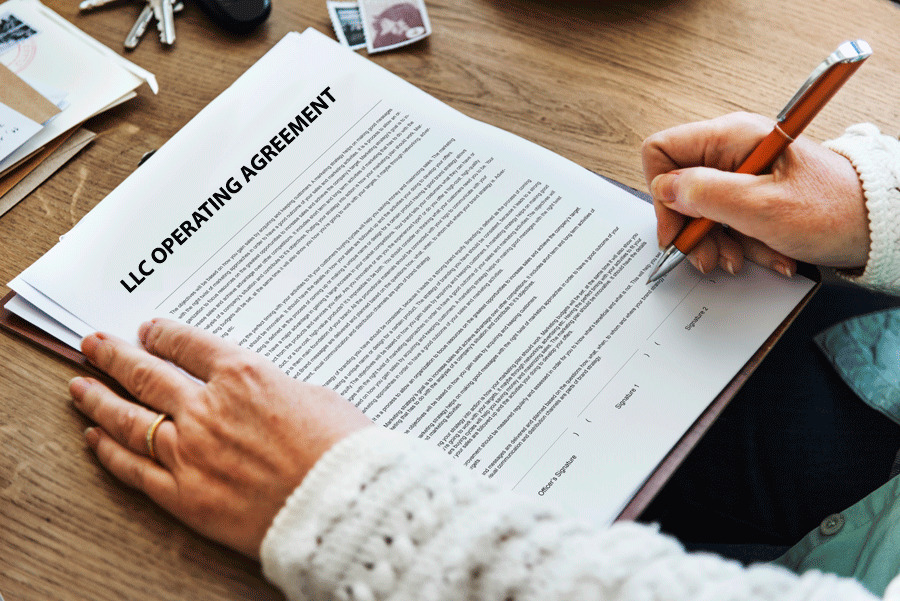Finding the perfect location to film a movie, music video, commercial, or any other project is crucial as it is often vital to the overall theme of the movie. However, once that perfect location is identified, producers and production companies are tasked with obtaining permission to film at that location through location release form, especially when it is privately owned.
A location release form/agreement is an important document that can help both the location owner and the production company create terms and conditions for the use of the premises.
Understanding what it is and what it should include will ensure that both parties are clear about the details of the use of the property.
This article explains what this form is and its essential components.
What is the Location Release Form?
A location release form is a formal document signed by anyone whose property is used by a specific individual or group for filming any content.
Its purpose is to show that the location owner has granted permission for his property to be used for filming content. In addition, this form should contain the dates of use, an insurance agreement in case of property damage, and an acknowledgment of the liabilities associated with using the property.
Film production companies often use this form when filming commercials, documentaries, music videos, and social content. The location scout is responsible for obtaining permission from the location owner.
Location Release Form Templates



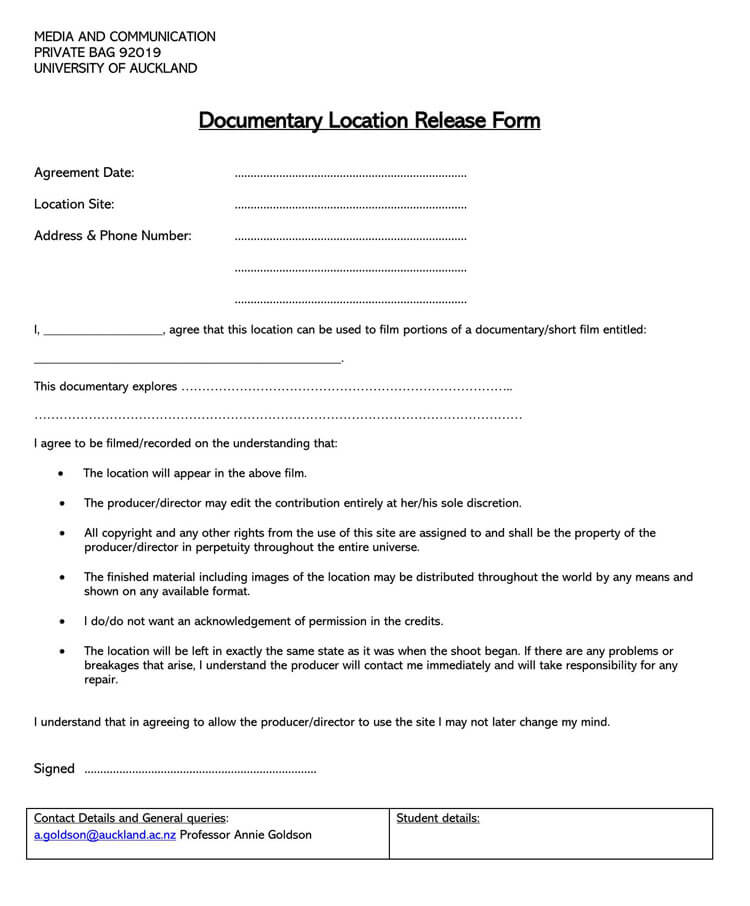


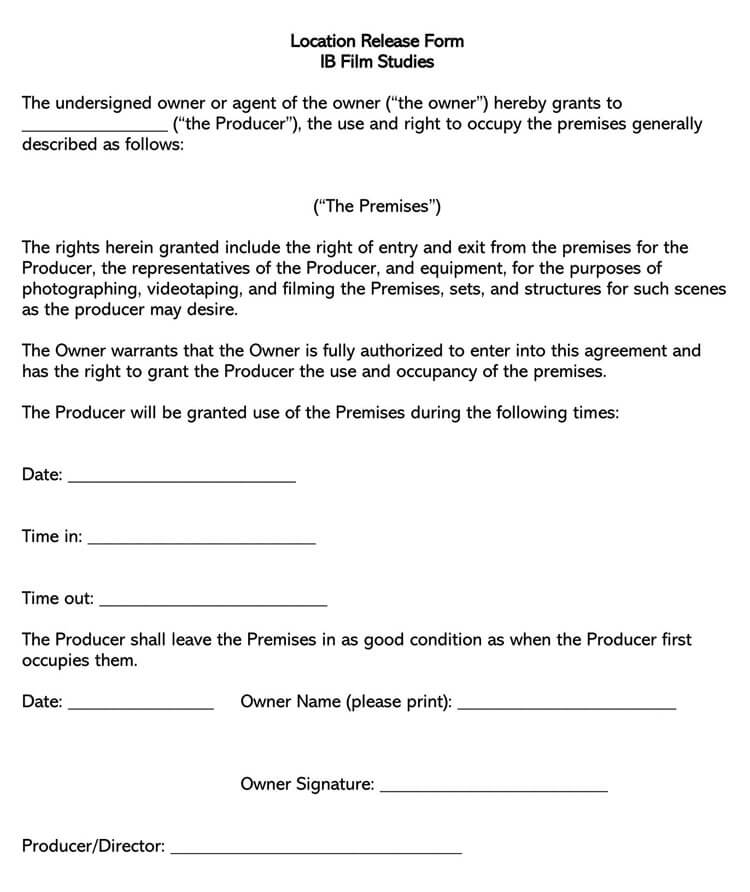
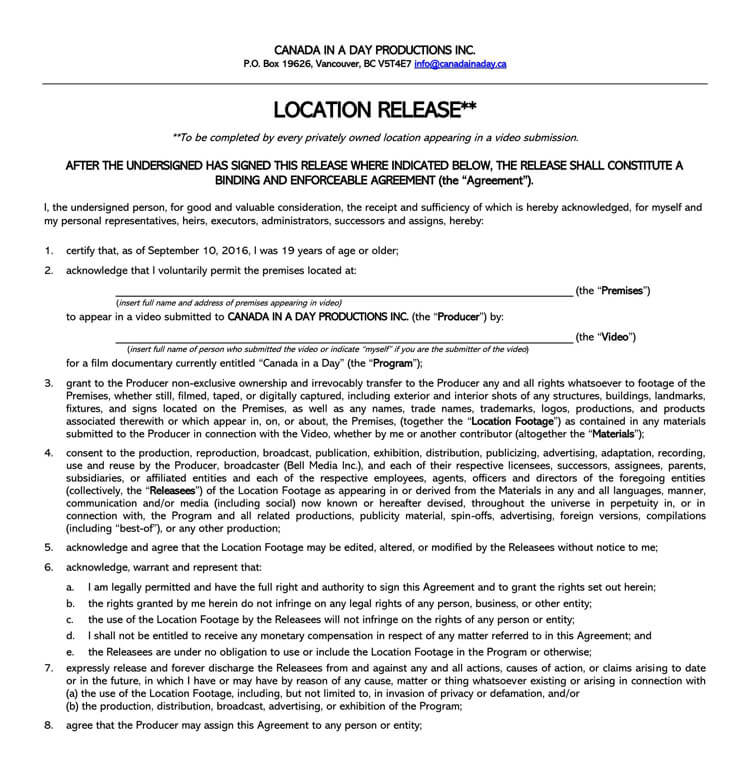
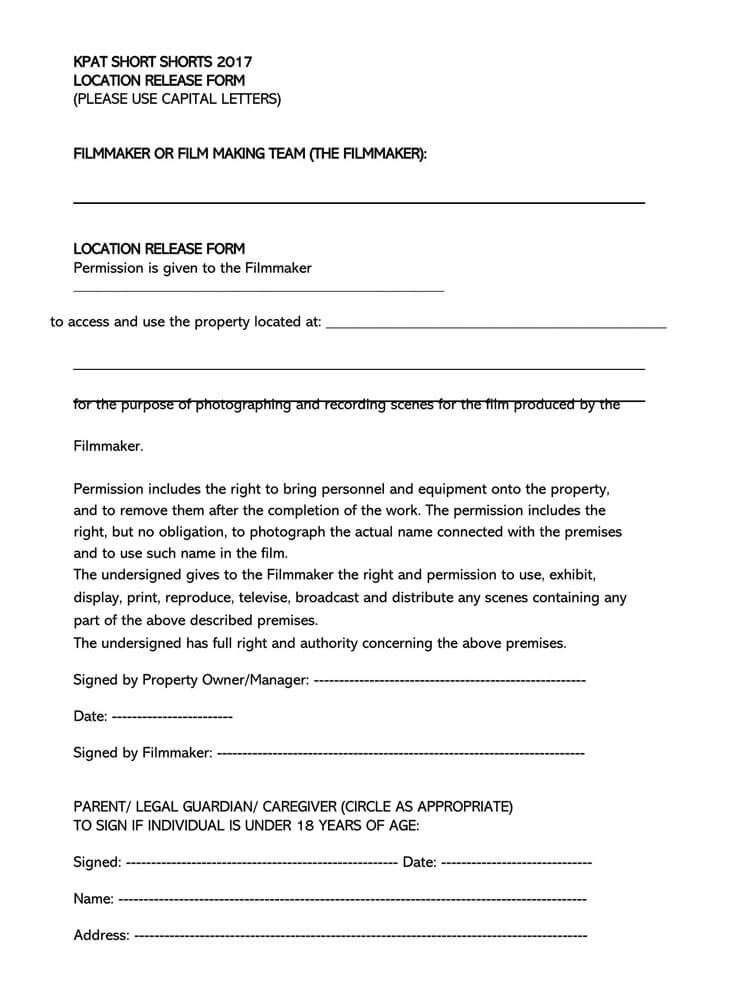


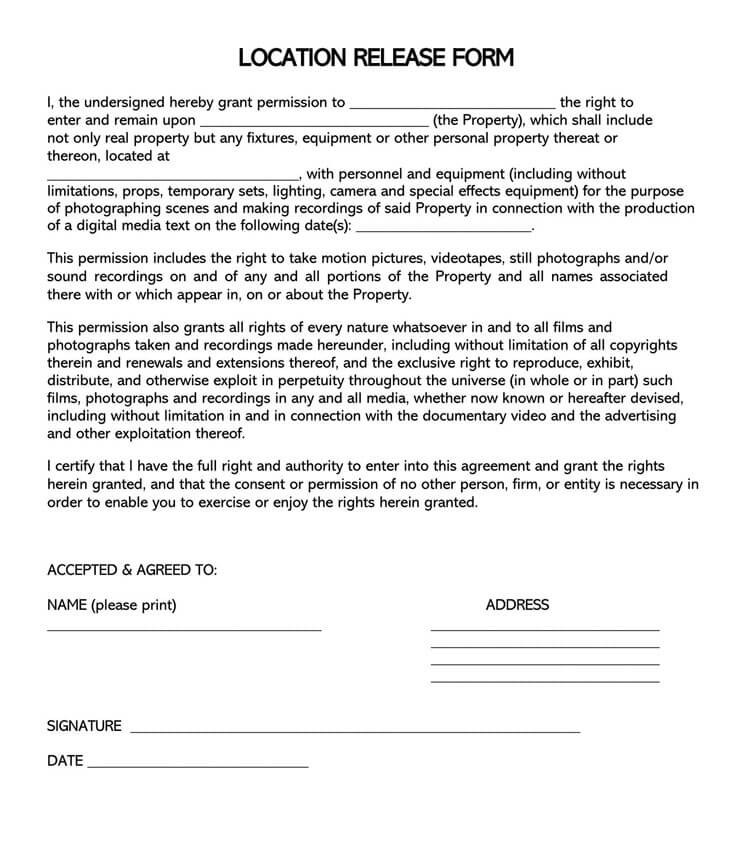
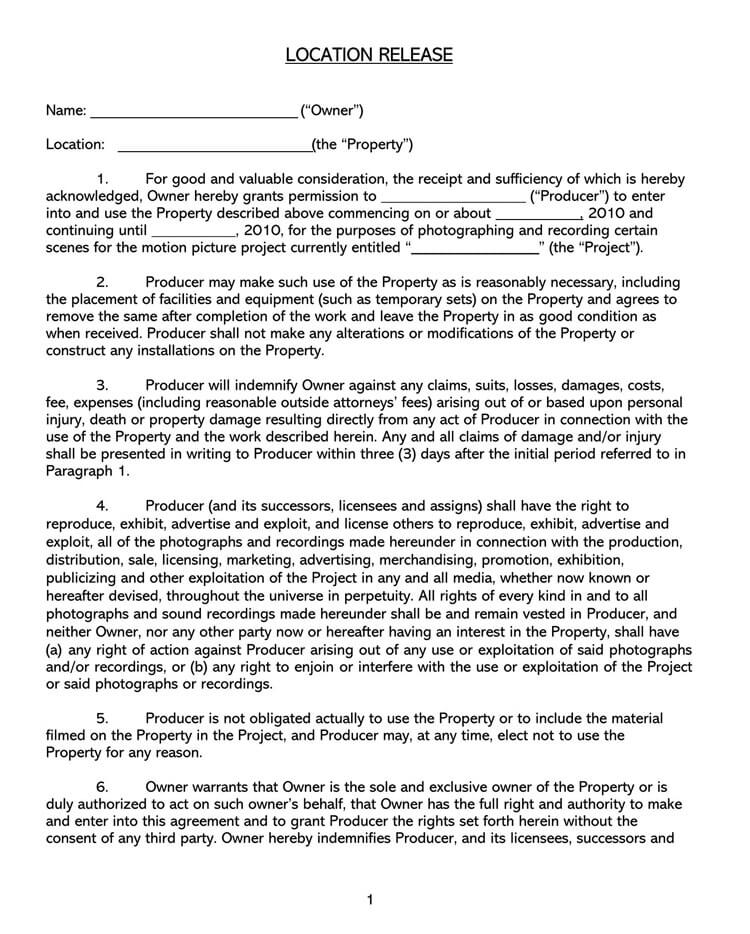
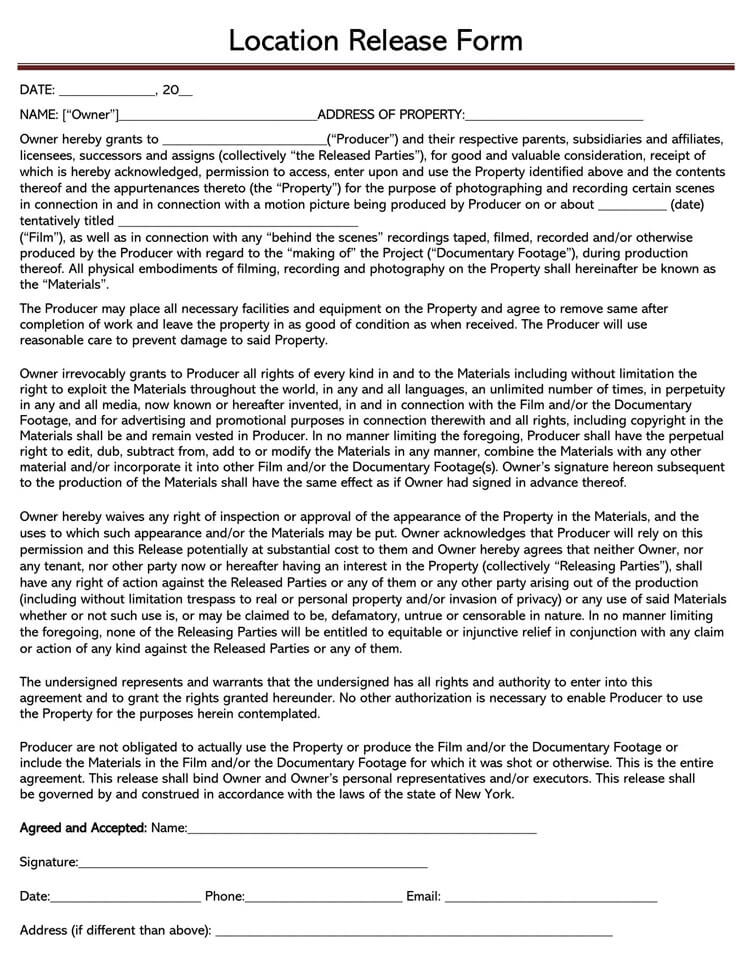

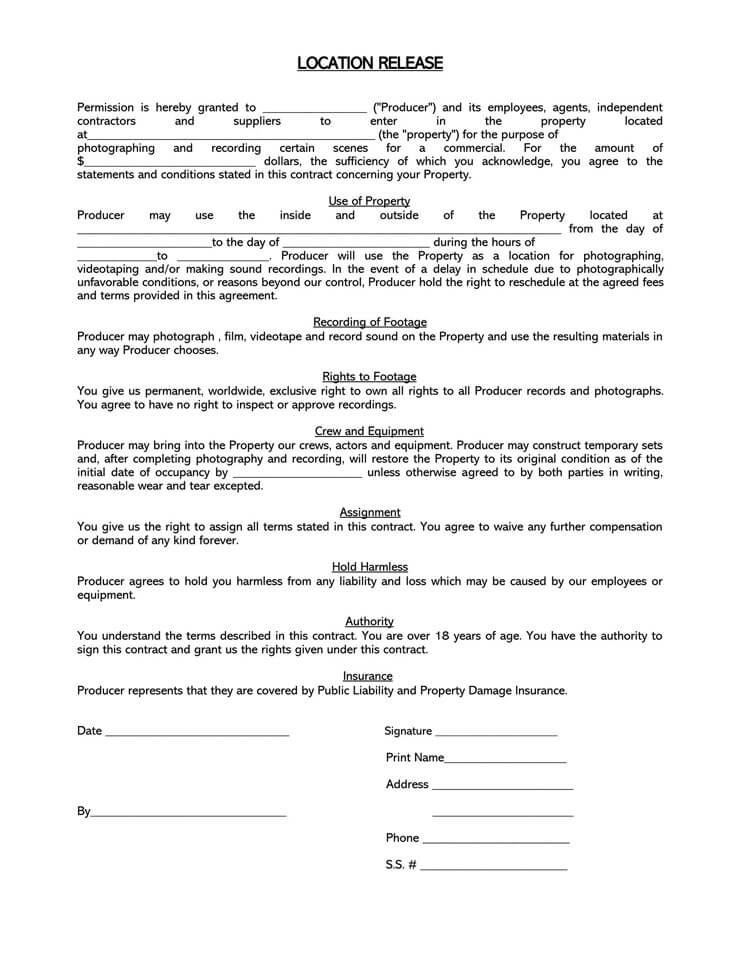
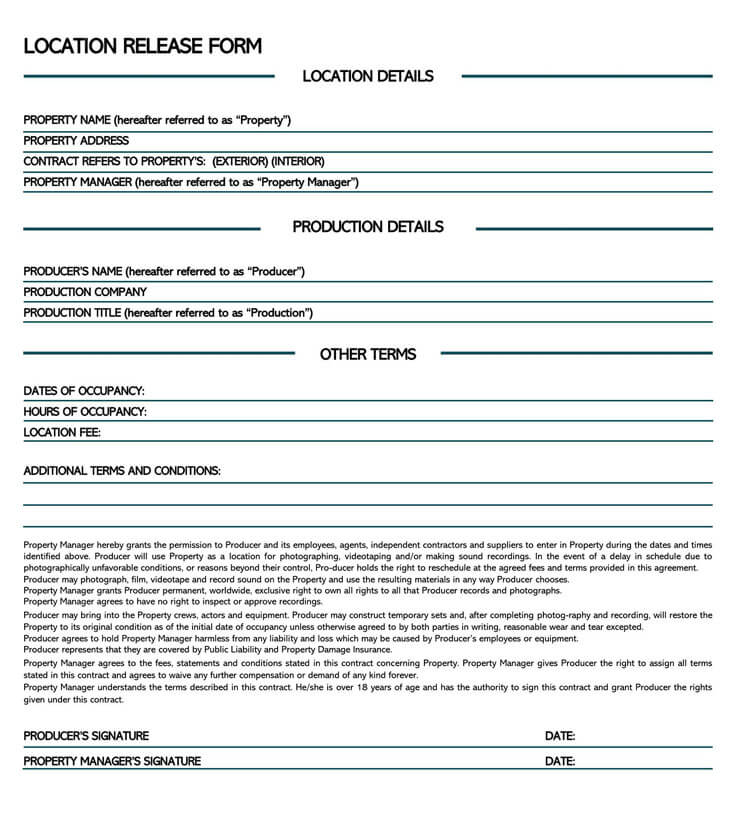
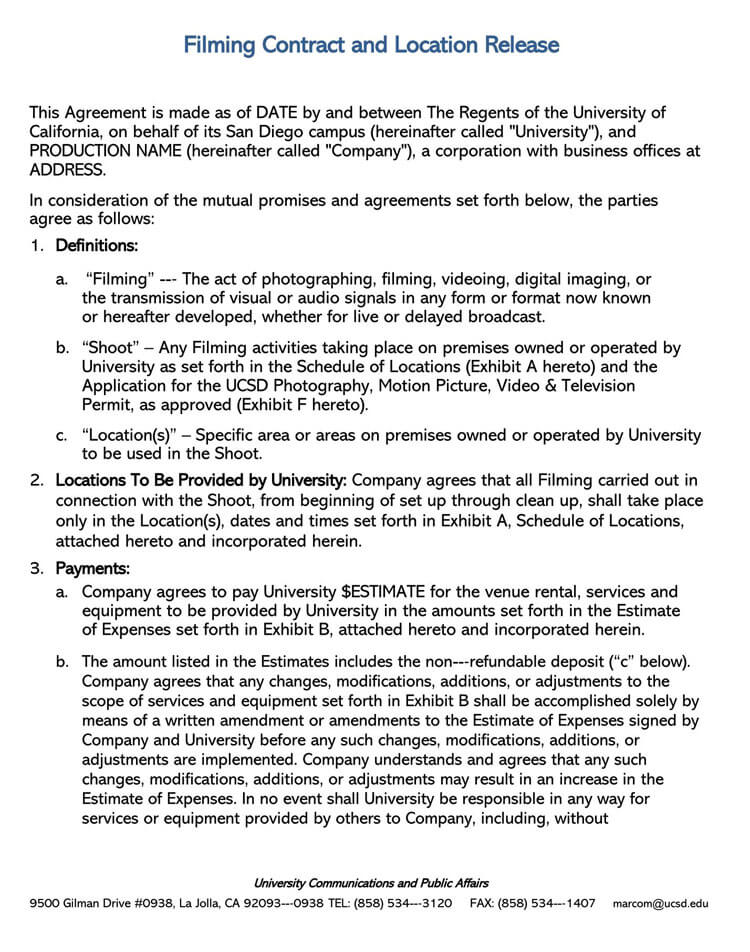

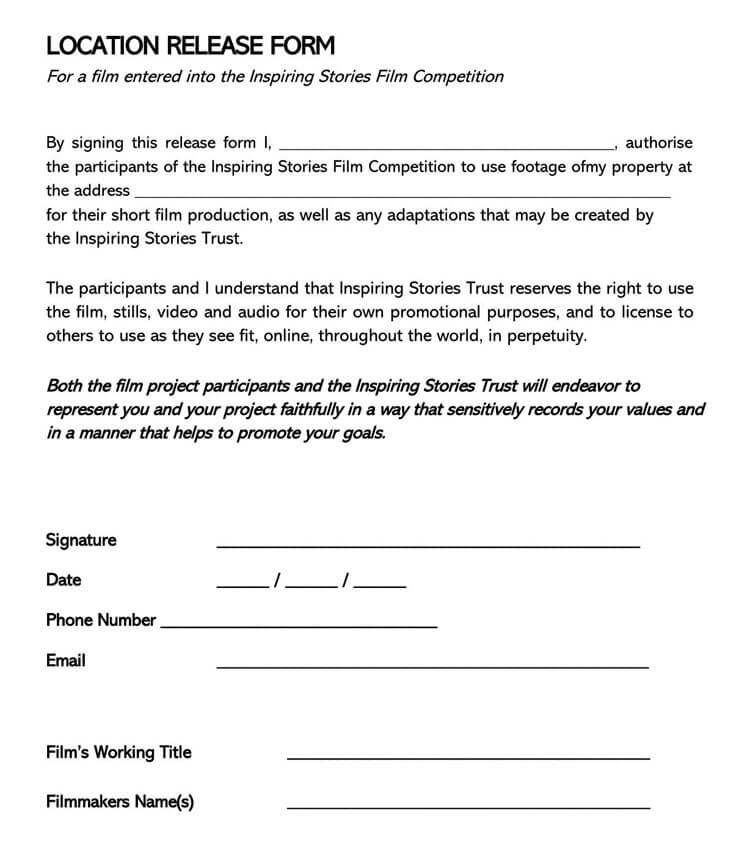

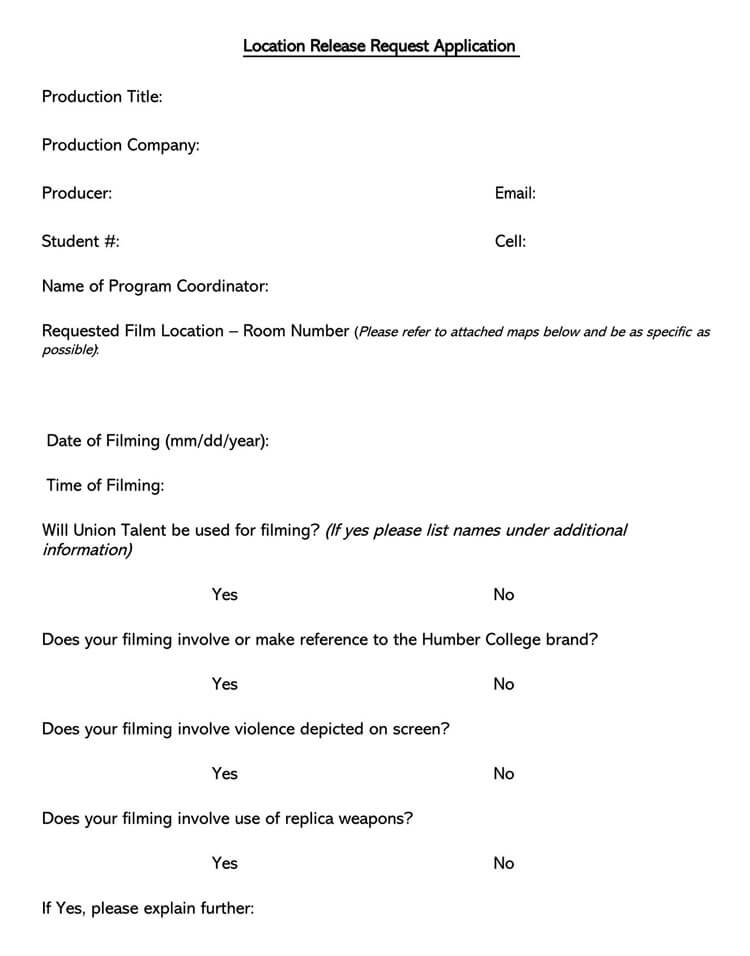
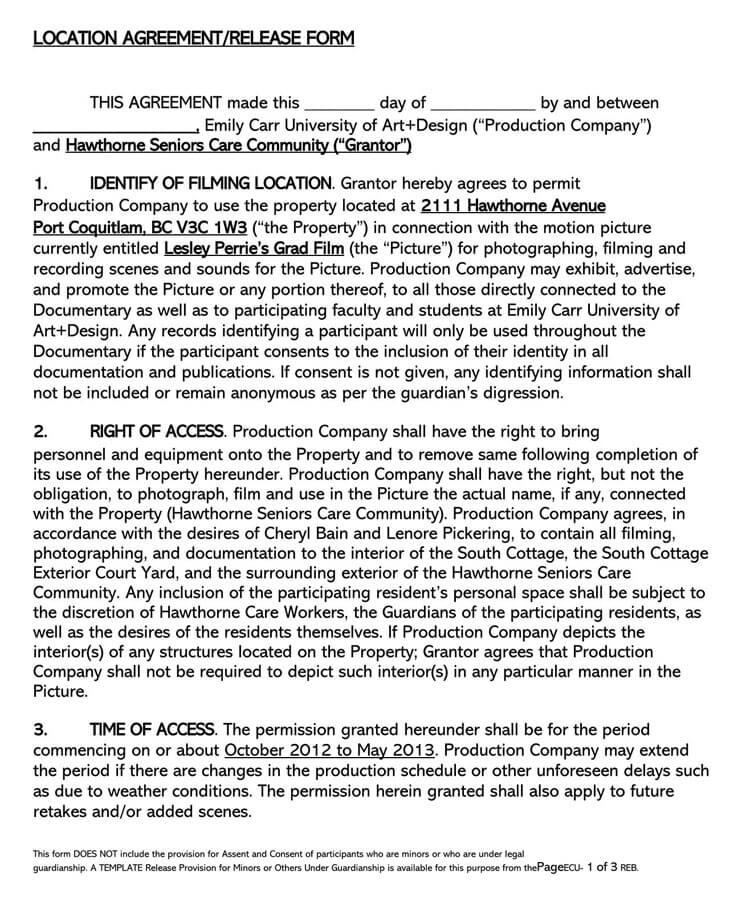
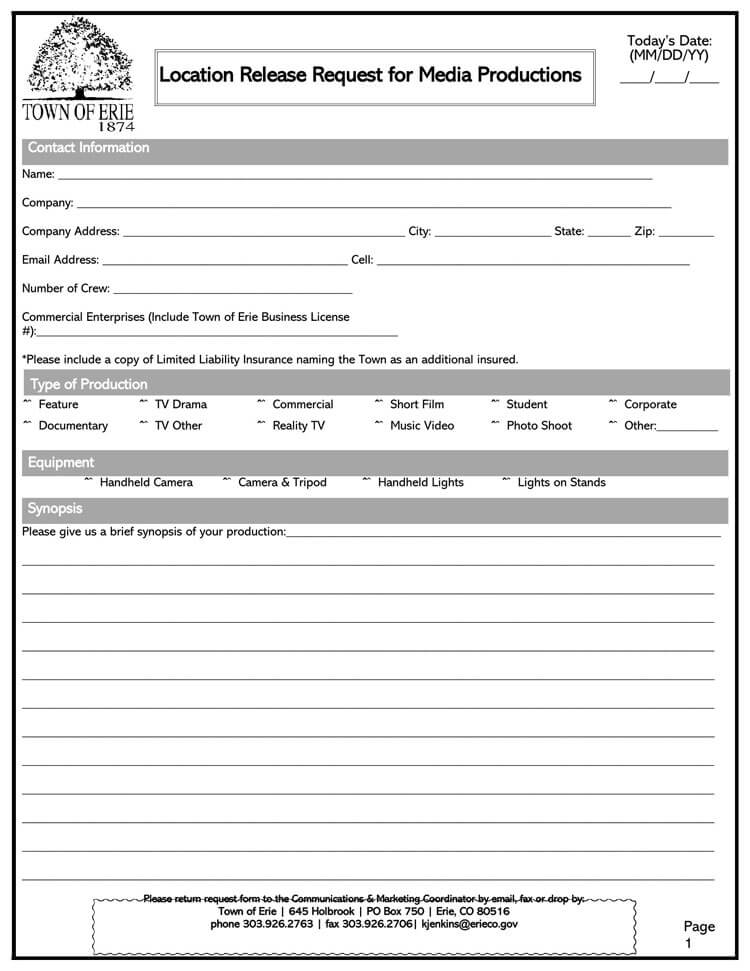

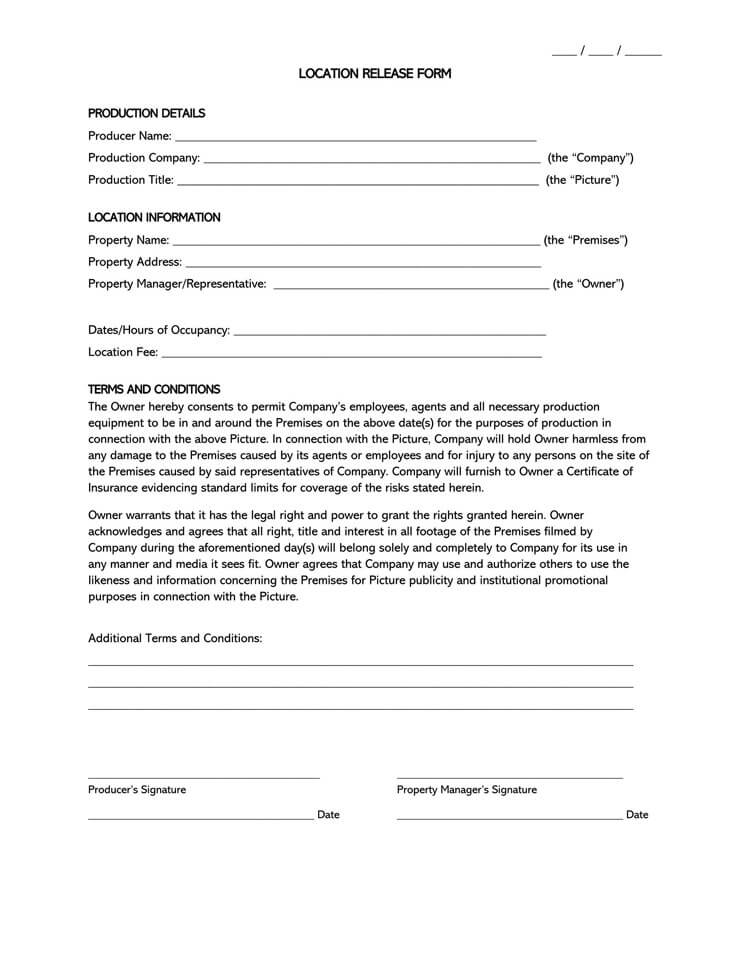

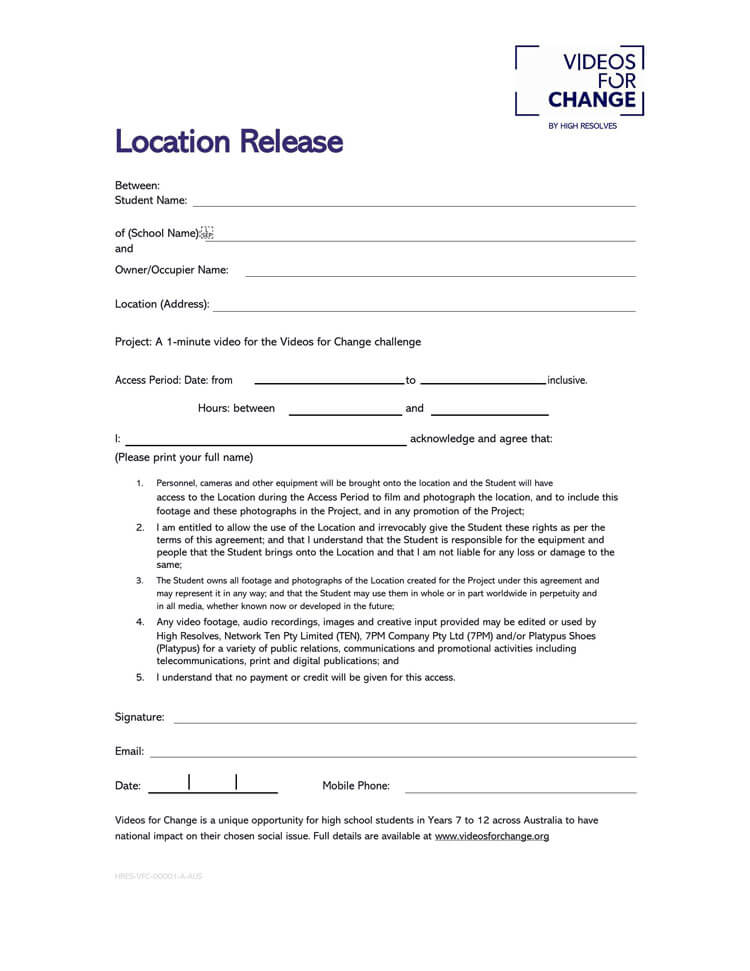

Importance
A release form authorizes a production company to legally create content on some property with the owner’s permission. It also ensures that the ownership of the footage belongs to the film company and is not disputed by the owner.
The form also plays an essential role in documenting the terms and conditions regarding the use of the premises, the amount and type of compensation expected by the owner, and the duration for which the premises would be used. This contract is legally binding and therefore safeguards both parties.
When to Use Location Release Form?
This form is used before the day the content is filmed. In the preproduction stage, the individual responsible for securing the location must agree with the property owner and sign the document. It helps settle any dispute over the filmmaker’s right to be at the location. It is also used in a lawsuit by either filmmakers or the location owner to prove that an agreement was signed.
pro tip
The form should first outline the details regarding the terms of use of the space. The owner should then sign and date it to show that permission has been granted. Finally, three copies should be made, one for the owner and the other for the production company. The final copy will be used on the day of shooting in the event of a dispute over the filmmaker’s right to use the property.
Must-haves of a location release form
The contents of this document are critical to ensuring that all details are accurately included in it. The names of the property owner and the production company, the property’s address, and the date on which the filmmakers are allowed to be on the property must be clearly and accurately mentioned in the form.
It must also highlight the compensation terms, restrictions set by the owner, any alterations that are permitted, and a statement outlining that the location owner releases the production company against any loss, costs, damages, liabilities, and claims.
The form should include a statement from the owner elaborating on how the film footage can be used. It should also outline straightforward remedies for a breach of the agreement and include a statement outlining the producer’s right not to use the location.
In addition, it should indicate if the production team is allowed to reassign the location to another party. It should also contain a section indicating that the owner is authorized to enter the property during filming. Finally, the producer and the property owner should sign the agreement. Both parties may also authorize representatives to sign the agreement on their behalf.
What to Include in Location Release Form?
The components of a filming location permission form help ensure that the document is comprehensive. A properly drafted form will help ensure that both parties set clear guidelines.
The following details should be included in the agreement:
Header
The form should include a header with a title that reads “Location Release Form.” The header helps identify what kind of agreement is being made. It should also contain other basic information about the two parties, which should be provided underneath the title.
Name of the owner
The full name of the property owner should be indicated. Indicating the name of the owner helps show who is releasing the property. If the property or location is co-owned, both owners’ names should be indicated.
Name of the production company
The full name of the production company should also be indicated. The producer’s name should be indicated if a production company is not in charge of the film. It helps ensure that the company or individual intending to use the location is properly identified.
Location address and its description
Next, the location should be identified by indicating its address. The address should include the street name, city, state, and zip code of the location. The form should then provide a clear description of the property. It should state the specific area where the filming will take place, especially if the location is spacious. This section makes sure that the property is properly described.
List of the Specifics
The document should then list specific details about the agreement. These details guide the use of the space and the interaction between the involved parties. A lack of clarity in this agreement section can lead to confusion and misinterpretation.
The following information should be listed:
Term
A clear statement indicating that permission has been granted should be indicated when outlining the terms. It should indicate that the production company can print, exhibit, and distribute scenes from the location while retaining the rights in perpetuity. It should also indicate that the scenes can be shot without the owner inspecting, consenting, or approving.
The date the location can be used
The date when the property will be used should also be outlined. It should also include a period or a start and end date; for instance, the production company can use the location for six months. It is recommended for production companies to overestimate the time needed slightly. This will help ensure that it has time to complete its project and incorporate re-shoots without asking for an extension from the location owner.
Location
The agreement should outline whether alterations to the location can be made. If changes are allowed, a statement should be made indicating that the production company will be expected to change the location back to what it was or make replacements. At the same time, the producer will instead bear all the responsibility at the location.
Footage
This form should clearly outline that the production company owns the footage shot at the location. The statement should also outline precise details about the use of the footage, like what the filmmakers can do with it and any information related to the property. The production company can use the footage for advertising, publicity, sales promotion, or other purposes. It is also essential that the document indicate that the filmmakers are free to decide whether to use the footage shot at the location.
Release
There may be losses, damages, or other claims that arise from the production and airing of footage of the property. This form should clarify that the producer is not responsible for such liabilities.
Remedy
The property owner should stipulate straightforward remedies if the producer violates the stipulated terms.
EXAMPLE
The release form may stipulate that the production company must compensate the owner if the property is damaged during production.
The producer should also indicate remedies that will be applied in the event of a disagreement with the owner to ensure that production is not halted unexpectedly. Both parties must ensure that the list of remedies is comprehensive to consider every possible scenario that may interfere with the agreement. Then, a solution that covers it is found and documented for future reference.
Assigning rights
The form should clarify whether the production company can reassign the location to a third party. If the production company is granted this right, the release form should state that the company may be secondarily liable for any document breach by the third party.
Miscellaneous
The agreement should also outline a miscellaneous clause covering the production company’s specific project information. For instance, it can stipulate the termination conditions for the agreement, etc.
Details of compensation
The amount of compensation the property owner will receive should then be outlined. It should also indicate when the production company will be expected to pay the amount. The agreement should also list the applicable payment method, such as checks, credit cards, etc.
Signatures
The owner’s signature and that of the representative of the production company should be indicated in the agreement. The signatures prove that both parties agree to the details outlined in the agreement. Therefore, the signatures should be indicated beside both parties’ full legal names.
Contact information
The email address and phone number of both the owner and the production company’s representative should also be indicated. The contact details ensure that both parties can be contacted if needed.
Date of the agreement
Finally, the date the agreement is signed should be indicated at the bottom of the form. The date will confirm when the agreement will legally come into effect and conclude the deal.
Conclusion
A location release form enables a production company to use a property with the owner’s permission. It mainly helps ensure that both the owner and the production company agree to the use of the property for recording purposes. It should contain the address and description of the property and a list of specific terms and details on compensation. It is also essential to include the date and time when the property would be used. Both parties should consider using a template for the form to help ensure that all relevant details are included and the agreement is comprehensive.










